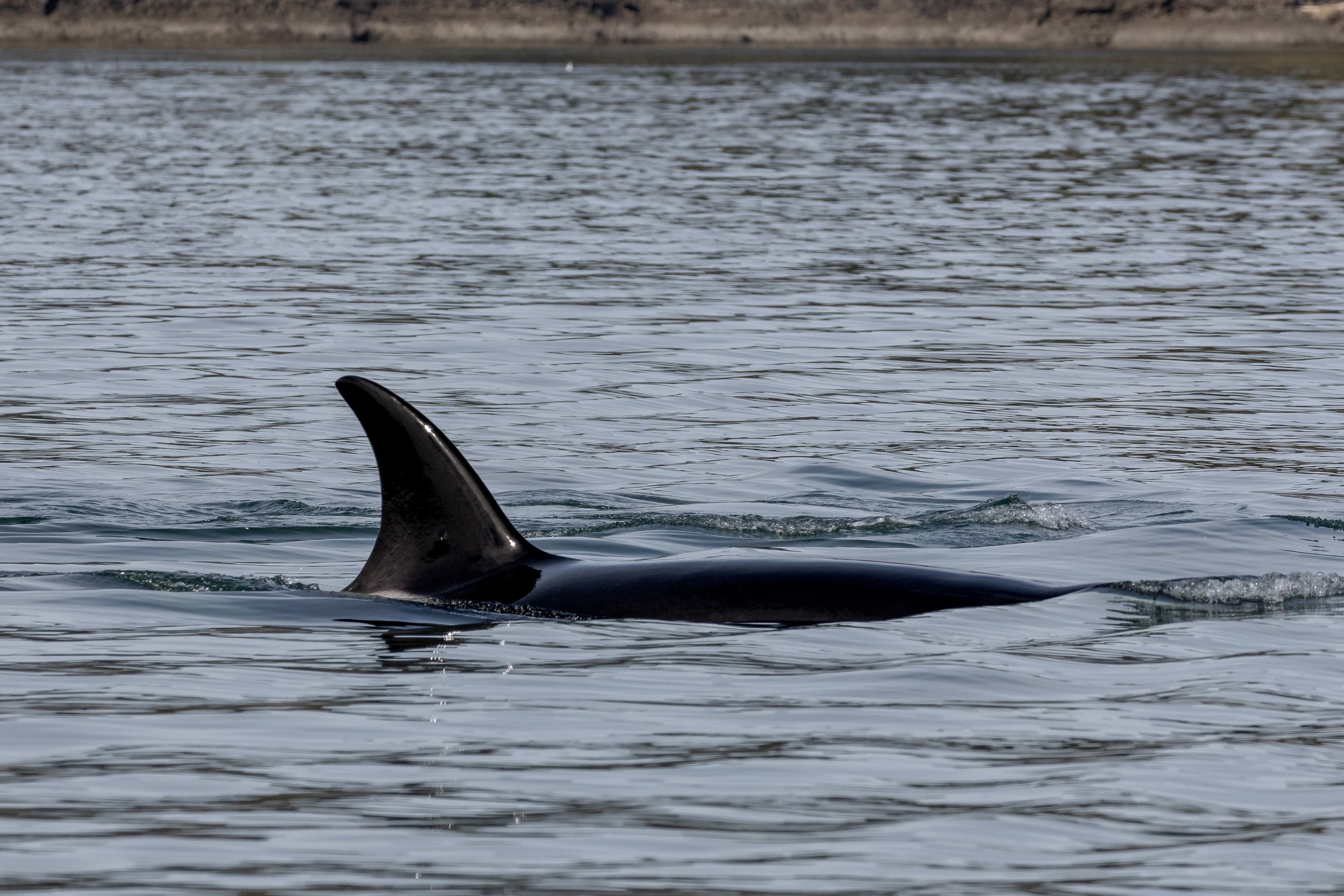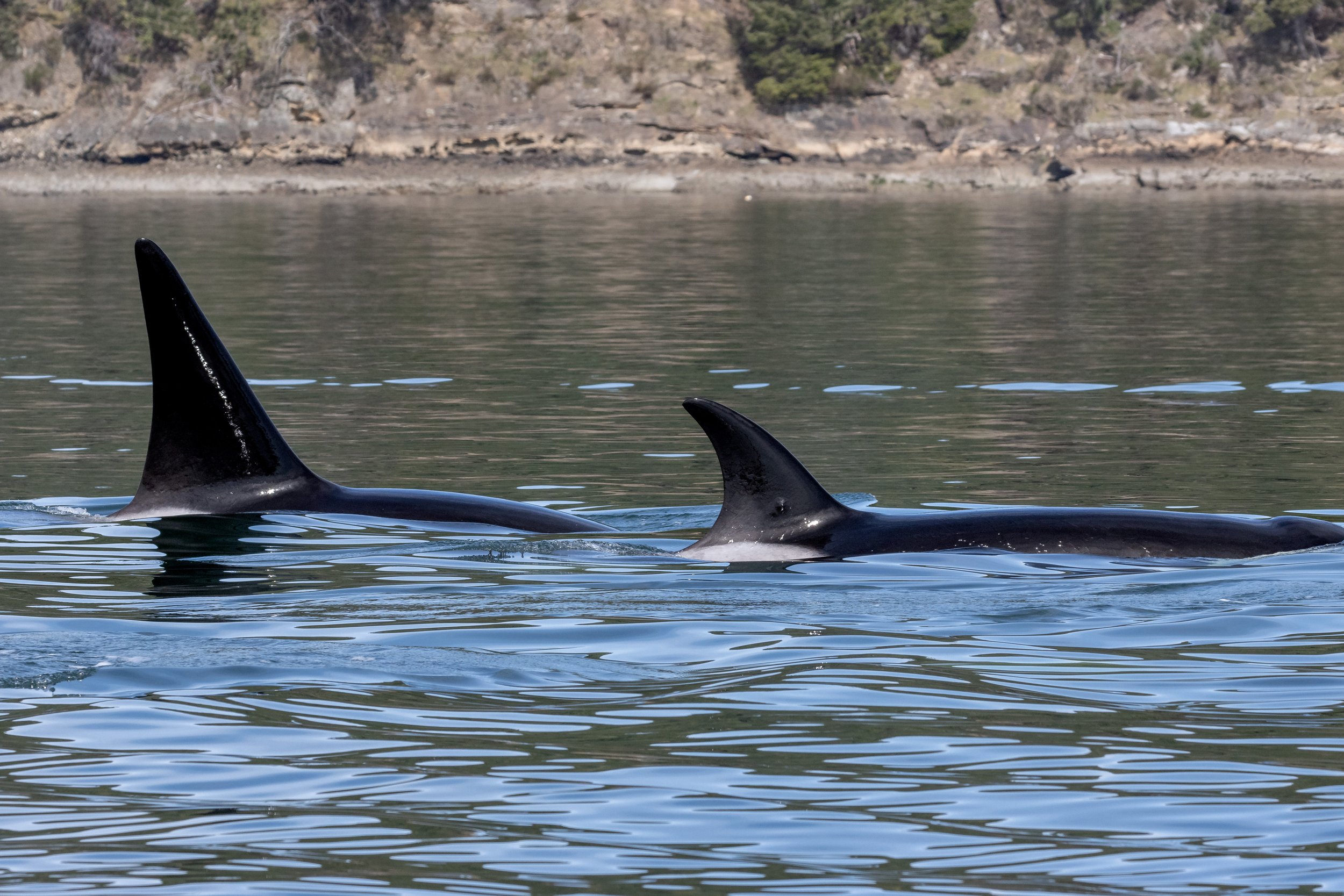March 29, 2023 - T090s in Active Pass
Today we headed out on the Salish Sea with eager eyes on the water hoping to spot some whales. The wind was keeping us out of the Strait of Georgia today, so we started to explore the inside of the Gulf Islands. Our geographical location spoils us as we have the option of taking on the calmer waters in this area, so we can keep our guests comfortable! We headed through Dodd Narrows and continued on our journey all the way to Active Pass.
Here we came upon some very active sea lions! We had backflips, porpoising and a lot of splashes. Then one of our vessels had a mechanical issue, and was down to one engine! Not to worry we have 2 for just this reason, we were still able to keep moving safely, just a little slower than usual. You may say this was perfect timing since we just happened to spot the T090’s at nearly the same time! We will only travel up to 7 knots when within 1 km of our whales, so our reduced speed was perfect. While spending time with the T090’s our other team members were preparing our other boat for a transfer, to make sure our guests got back in a timely manner. Since we spend up to an hour with each group of whales we see, it wasn’t too long after the whales that the crew arrived and we got to switch vessels. These lucky guests got to experience both types of boats in a single tour!
The T090’s consist of four Orca:
T090 ♀ Eagle (1980)
T090B ♂ Piglet (2006)
T090C ♀ Tigger (2010)
T090D Kanga (2017)
What’s fascinating about these Orca? They are the apex predator of the ocean, and this pod has lived up to that title! They have been documented using the log booms to hunt the Sea Lions. They do this by living up to another nickname: the Wolves of the Sea. Creeping up silently, moving in on the sea lions. It is surely a sight to see when Piglets’ towering dorsal fin pops up among the sleeping sea lions on the logs. Just waiting to catch one off guard. Orca are incredibly intelligent social animals that have culture and teach each other these techniques. This is why we see very different hunting styles among the different matrilines, pods and ecotypes of Orca worldwide.
In Patagonia, there are some Orca that will come ashore to hunt the seals, sea lions and particularly their pups. They will swim sideways to hide their dorsal fins and literally beach themselves to catch their prey. WOW! Sounds dangerous, and it can be. That is why when the young Orca are taught this particular way of hunting some of them only try it once and decide this is not for them. The more experienced make it look like a breeze maneuvering themselves back into the ocean, hopefully with a mouthful of sea lion to make it worth the risk.
In the icy waters of Antarctica, there are Orca that use a coordinated attack known as “wave crashing.” This is a targeted attack on prey on the icebergs. The orca will charge together very quickly moving under the iceberg creating a wave that crashes into it breaking it up into pieces. When the Seal attempts to hide on the smaller chunks of ice, they return again rushing under the berg to rock it knocking the seal into the water. Here they work together to make sure the Seal has little chance of escape!
We even had a pod of Orca here in B.C. who have been speculated to have attempted to learn to hunt in the shallows, similar to those of Patagonia. It is thought, but not confirmed, that this is how a mother T123 Sidney and her son T123A Stanley may have ended up beached. This was an incredibly stressful account as Sidney was pregnant at the time. All three Orca thankfully survived this occurrence, but we think it’s safe to assume this technique was probably not for them.
Please enjoy the photos of our tour today taken by our Marine Naturalists Cheyenne Brewster and Aly Kohlman.
T090’s. Photo by Aly Kohlman.
T090 Eagle (left) and T090C Tigger (right). Photo by Aly Kohlman.
T090 Eagle breaking the surface of the water! Photo by Cheyenne Brewster.
T090B Piglet. Photo by Cheyenne Brewster.
T090C Tigger. Photo by Cheyenne Brewster.
T090 Eagle. Photo by Cheyenne Brewster.
T090 Eagle. Photo by Cheyenne Brewster.
T090D Kanga. Photo by Cheyenne Brewster.
T090B Piglet (left) and T090 Eagle (right). Photo by Cheyenne Brewster.
T090B Piglet (left), T090 Eagle (center), and T090C Tigger (right). Photo by Cheyenne Brewster.
A cuddle puddle of Sea Lions. Photo by Cheyenne Brewster.
Another cuddle puddle! This time it’s full of Harbour Seals. Photo by Cheyenne Brewster.
Can you spot all the Harbour Seals in this photo? They blend in well with the rocks, don’t they? Photo by Aly Kohlman.
Bonus points if you can spot the birds in this photo! Photo by Aly Kohlman.
There are six Harbour Seals here, can you spot the one sporting the camouflaged spread out on the rocks? Photo by Aly Kohlman.
Photo by Cheyenne Brewster.
















